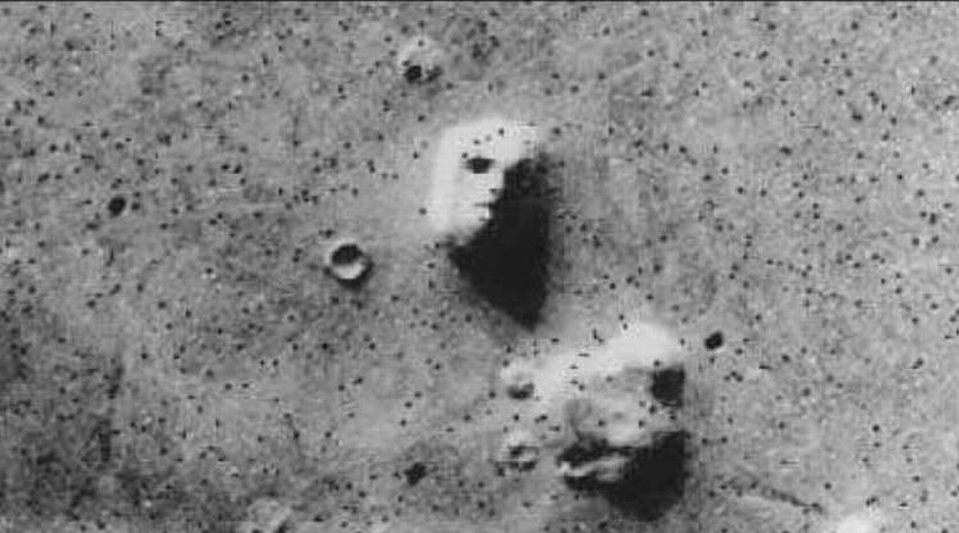Pareidolia: The face on Mars and building narrative
Seeing patterns where there aren’t any. This is something we do all the time and is referred to as Pareidolia. And when I say all the time – I mean ALL the time. As in – the primary function of that lump of grey matter between our ears is to extract patterns from noise. Our senses are bombarded with a non-stop, overwhelming, miasma of information every split second – and from this wheeling, curdling mayhem we need to decide – do I cross the street before that car or after it. And in every stage of that decision – your eyes breaking down the visual scene into objects, deciding what lines and shapes belong to which object, which objects are closer than others, how fast each object is travelling and their likely continued trajectories – ALL of these inferences are just that: Inferences.
 We are postulating given outcomes from a set of data. We are seeking the patterns present in the world around us. If there could be said to be one major over-riding function of our brains it is this: detect the patterns!
We are postulating given outcomes from a set of data. We are seeking the patterns present in the world around us. If there could be said to be one major over-riding function of our brains it is this: detect the patterns!
This tendency towards pattern detection manifests in all sorts of interesting ways but interestingly – it seems to be present at all levels of our perceptual and cognitive engines. Ie: at the lowest level, at raw visual scene analysis, we will group things together, we will see dragons in the clouds, a man in the moon – in pretty much ANY randomly distributed stimuli we are likely to be able to see patterns in if we try. But at the other end of the scale – in the emergent high level artifacts of our qualia – we also want to see patterns.  We ascribe rationales to events that are essentially chaotic. We come up with ideas such as Karma, or the intervention of gods, or subscribe causes such as the movements of stars to the effects such as our partner is suddenly acting differently, in order to try to come to terms with what is essentially, a very chaotic and largely narrative-less existence. Ah… There’s that word again. Narrative. Indeed this pattern-sensing proclivity of ours is such a ubiquitous feature that we give it many names. Ascribing cause to effect is one. And another is building narrative. We frequently build stories around events even when they are completely unconnected. We like to think that the dude trod in dog poo as karma, or some sort of natural justice because he just stole the car park from that little old lady – but really – we are just spinning stories around non-connected events. It’s what we do all the time, and many lifetimes of research have so far failed to come up with any actual evidence for an over-riding force that dictates events here on Earth.
We ascribe rationales to events that are essentially chaotic. We come up with ideas such as Karma, or the intervention of gods, or subscribe causes such as the movements of stars to the effects such as our partner is suddenly acting differently, in order to try to come to terms with what is essentially, a very chaotic and largely narrative-less existence. Ah… There’s that word again. Narrative. Indeed this pattern-sensing proclivity of ours is such a ubiquitous feature that we give it many names. Ascribing cause to effect is one. And another is building narrative. We frequently build stories around events even when they are completely unconnected. We like to think that the dude trod in dog poo as karma, or some sort of natural justice because he just stole the car park from that little old lady – but really – we are just spinning stories around non-connected events. It’s what we do all the time, and many lifetimes of research have so far failed to come up with any actual evidence for an over-riding force that dictates events here on Earth.
But what does this have to do with Interaction I here you ask. Well I’m glad you asked.
Check out the menus available at the top of the page at Skype.com. In the same way that we will create patterns and narratives out of the most unconnected things – here, with this sequence of menus – a narrative emerges. It’s a course of events that you are about to engage with. Firstly, you want to find out about how this product works, and then, having decided it’s kind of cool, you want to know how much it costs. Then having made the decisision to buy – you want to download the application and install it. And then inevitably – you will need support – coz it didn’t work properly. Can you see how the story here unfolds and the unintended message that this simple ordering of menus creates? This simple sequence of objects creates the message that you will inevitably need support – that things are going to go wrong. Every design element you use adds to the story. Every layout decision changes the narrative that we weave into the world we inhabit.




 Address: 5 Day St, Marrickville, Sydney, Australia
Address: 5 Day St, Marrickville, Sydney, Australia Phone: +61 2 (0) 404 214 889
Phone: +61 2 (0) 404 214 889 Email:
Email: 